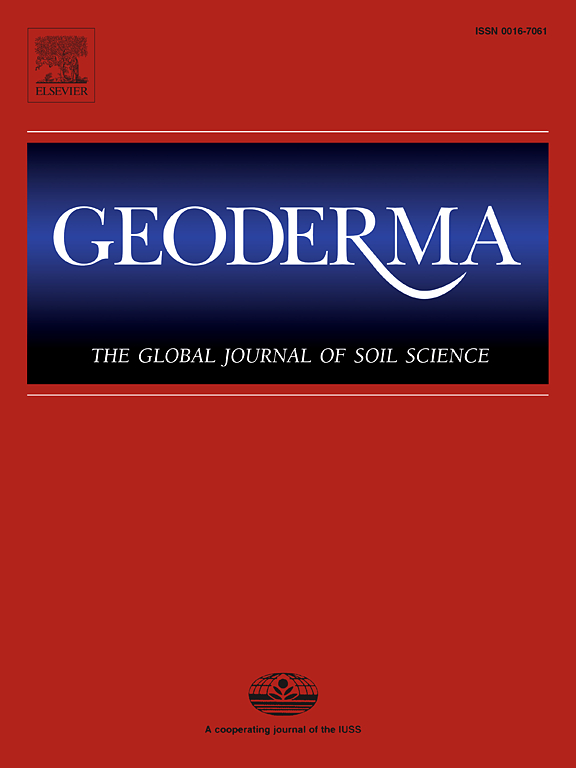Moisture-driven shifts in microbial nitrogen limitation under biochar and nitrification inhibitors co-application in tropical soils
IF 6.6
1区 农林科学
Q1 SOIL SCIENCE
引用次数: 0
Abstract
Biochar and nitrification inhibitors (NIs) are crucial in improving soil nitrogen (N) availability and decreasing its environmental consequences in agroecosystems. Soil microbes can regulate soil N dynamics through metabolic processes, such as the secretion of extracellular enzymes, which affect both N production and turnover. However, how and why soil microbial N limitation (MNL) responds to biochar-NIs co-application is poorly understood, especially in tropical regions under different moisture contents. Here, an incubation study was conducted on soils from a long-term rice-vegetable rotation to investigate the effects of five treatments including control (no biochar or NIs), 2 % biochar, 2 % biochar plus 5 % dicyandiamide (DCD), 2 % biochar plus 1 % 3,4 dimethylpyrazole phosphate (DMPP), and 2 % biochar plus 2.5 % DCD and 0.5 % DMPP, at 60 % and 100 % water holding capacity (WHC) on MNL and N availability. Biochar derived from rice straw was applied at a rate of 40 Mg ha−1. All treatments, including the control, received 150 mg N kg−1 as urea, with NIs added proportionally to the applied N mass. The vector-threshold element ratio was applied to evaluate MNL, while δ15N and net N transformation rates were measured to evaluate N availability. The vector-threshold model results indicated severe MNL in studied soils, and that biochar, alone or with NIs, increased δ15N and alleviated the MNL under unsaturated conditions, while the opposite was observed under saturated conditions. Biochar increased the particulate and dissolved organic carbon contents, which in turn increased the net N mineralization rate, thereby alleviating MNL under unsaturated conditions. Relative to biochar, biochar-NIs co-application increased net N mineralization rate under unsaturated conditions. The lower nitrate production in response to biochar, alone or with NIs, decreased δ15N and aggravated MNL under saturated conditions. Among all NIs treatments, biochar + DMPP showed the highest net N mineralization rate, but the lowest MNL at 60 % WHC and the highest MNL at 100 % WHC. Nitrous oxide emissions increased in response to biochar alone, but decreased under biochar-NIs co-application in unsaturated and saturated soils, with the lowest emissions observed for biochar + DCD at 60 % WHC and biochar + DCD + DMPP at 100 % WHC. Our results indicated that soil moisture conditions control the response of MNL and N losses to biochar and NIs in the tropics.

热带土壤生物炭与硝化抑制剂共同施用时微生物氮限制的水分驱动变化
在农业生态系统中,生物炭和硝化抑制剂对改善土壤氮素有效性和减少其环境后果至关重要。土壤微生物通过胞外酶的分泌等代谢过程调节土壤氮素动态,影响氮素的产生和周转。然而,土壤微生物氮限制(MNL)对生物炭-氮共施的响应机制和原因尚不清楚,特别是在不同含水量的热带地区。本研究在长期水稻-蔬菜轮作土壤上进行了培养研究,研究了5种处理,包括对照(无生物炭或NIs)、2%生物炭、2%生物炭加5%双氰胺(DCD)、2%生物炭加1% 3,4二甲基吡唑磷酸盐(DMPP)、2%生物炭加2.5% DCD和0.5% DMPP,在60%和100%持水量(WHC)下对MNL和N有效性的影响。从稻草中提取的生物炭以40 Mg ha−1的速率施用。包括对照在内的所有处理均以尿素形式施用150 mg N kg - 1,按施氮量比例添加NIs。利用矢量阈值元素比评价MNL,利用δ15N和净N转化率评价氮素有效性。载体阈值模型结果表明,在非饱和条件下,生物炭单独使用或与NIs一起使用均能增加土壤的δ15N,缓解土壤的MNL,而在饱和条件下则相反。生物炭增加了颗粒碳和溶解有机碳含量,从而提高了净氮矿化率,从而缓解了不饱和条件下的MNL。与生物炭相比,在不饱和条件下,生物炭与氮素共施提高了净氮矿化率。在饱和条件下,生物炭单独或与NIs共同作用导致硝酸盐产量降低,δ15N降低,MNL加重。在所有氮素处理中,生物炭+ DMPP的净氮矿化率最高,但60% WHC时MNL最低,100% WHC时MNL最高。在非饱和和饱和土壤中,生物炭+ DCD和生物炭+ DMPP在60% WHC和100% WHC时的排放最低,而生物炭+ DCD + DMPP在单独施用时的排放增加,而生物炭+ DCD + DMPP在非饱和和饱和土壤中则减少。结果表明,土壤水分条件控制了热带地区氮素和MNL流失对生物炭和NIs的响应。
本文章由计算机程序翻译,如有差异,请以英文原文为准。
求助全文
约1分钟内获得全文
求助全文
来源期刊

Geoderma
农林科学-土壤科学
CiteScore
11.80
自引率
6.60%
发文量
597
审稿时长
58 days
期刊介绍:
Geoderma - the global journal of soil science - welcomes authors, readers and soil research from all parts of the world, encourages worldwide soil studies, and embraces all aspects of soil science and its associated pedagogy. The journal particularly welcomes interdisciplinary work focusing on dynamic soil processes and functions across space and time.
 求助内容:
求助内容: 应助结果提醒方式:
应助结果提醒方式:


